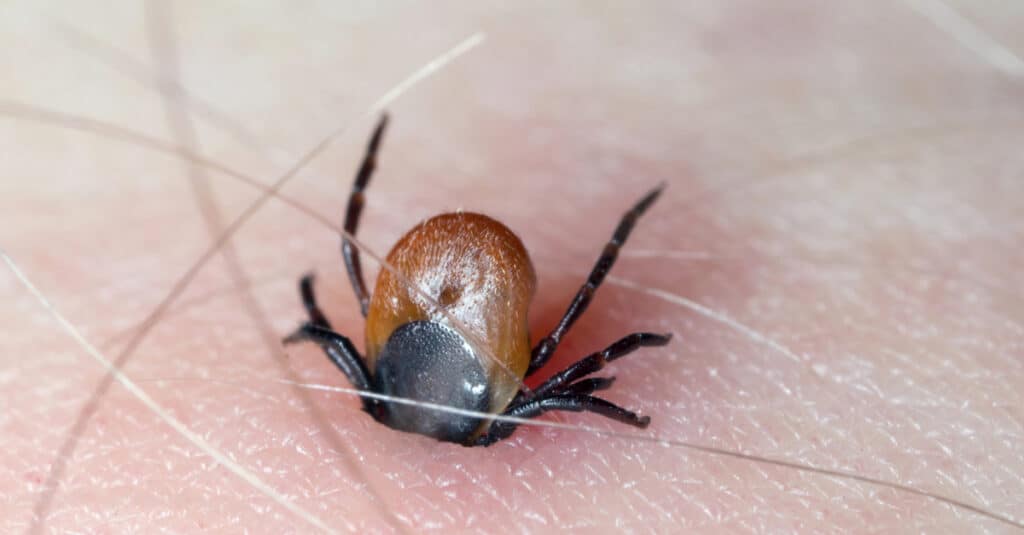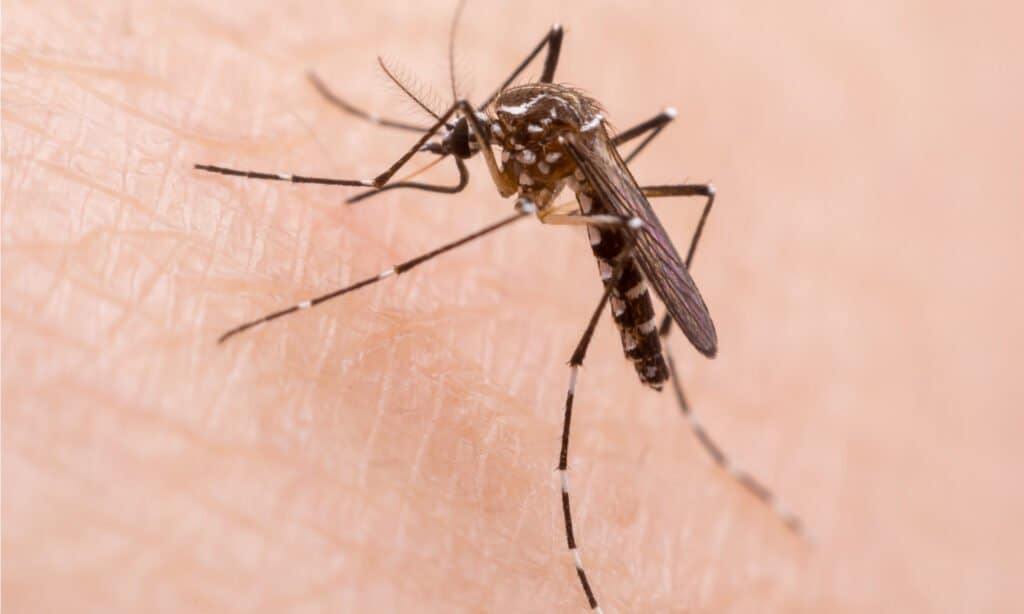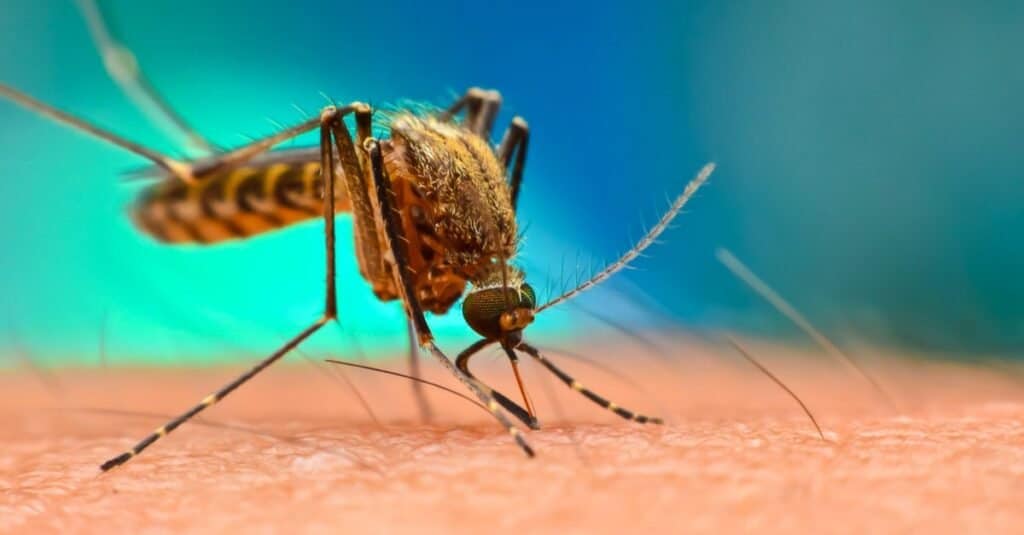Zoonotic diseases are diseases that are transmissible from animals to humans and vice versa. The active transference modes of these infecting agents can be viral, bacterial, parasitic, or mycotic.
An estimated 76 million people fall ill yearly from zoonotic diseases in the United States alone, and roughly 9 million cases are severe enough to require medical attention. Vaccinations can prevent many zoonotic diseases; others are less preventable and pose a significant risk to human health.
This blog post discusses animal-borne diseases. We will describe each illness briefly, including its symptoms and the transference of the disease. We hope that you read this information and become aware of the existence of these zoonotic diseases. If you are aware of these diseases, you can possibly recognize their symptoms and get help early to maintain your health.
1. Lyme Disease

Deer ticks are known carriers of Lyme disease.
©Tomasz Klejdysz/Shutterstock.com
Lyme disease and its effects come from a bacterial infection, often transmitted through a tick or flea bite. The bacteria, Borrelia burgdorferi, causes an inflammatory response in the body that can lead to a range of symptoms, including:
- Rash in a bulls-eye pattern
- Fever
- Chills
- Fatigue
- Body aches
- Headache
- Neck stiffness
- Swollen lymph nodes
The medical profession often uses antibiotics to treat Lyme disease. This treatment can be effective if caught early. However, Lyme disease is typically misdiagnosed as it mimics other illnesses. Consequently, many people with Lyme disease go undiagnosed for years. When undiagnosed for extensive periods, this and other zoonotic diseases with mild symptoms can become chronic. If these diseases move to the chronic stage, they ravage health, frequently irreparably.
And while the media is full of celebrities suffering from Lyme and other zoonotic diseases raising awareness about these infections, we hear little about the effects of these infections on the lives of ordinary people.
Misdiagnosed Lyme Disease – Effects on an Ordinary Life
Janet Murray is one such ordinary person who continues to suffer the symptoms of zoonotic infections. She lived approximately 30 years of her life with several misdiagnosed zoonotic diseases, including spotted fever, Q fever, and chlamydia pneumonia, all mimicking Lyme disease symptoms. Janet recounts her journey with zoonotic diseases in her memoir ‘My Sub-Lyme Life.’
A quote from Janet’s book passionately describes her experience.
‘Today, it doesn’t matter to me as a layperson whether one calls the tick-bite infections spotted fever, tick bite fever, rickettsia, Coxiella burnetii, Borrelia burgdorferi, Lyme disease, or any other name. To me, the effects are the same, which is the almost total destruction of health and any concomitant quality of life.’
Janet acquired her first zoonotic infection (Q fever) from unpasteurized milk before reaching a year old. Two separate spotted fever infections followed before reaching 12 years. Unfortunately, it was only at 36 that she received a proper diagnosis. What ensued was years of antibiotics and other treatments, some with better effects than others. Despite all that Janet has been through, she remains optimistic. She is an advocate for others suffering from Lyme and other zoonotic infections.
Celebrities With Lyme
Celebrities like Justin Bieber, Yolanda Hadid, and Kelly Osbourne have shared their experiences of living with the impacts of Lyme in their daily lives.
In 2020, Justin Bieber announced he was living with Lyme disease. This announcement surprised many, as the singer had not been publicly open about his health in recent years. However, the news is a reminder that Lyme disease can affect anyone, regardless of age or lifestyle.
In the case of the famous model Yolanda Hadid, she describes her struggles with Lyme as darkness, pain, and an unknown hell.
As for Kelly Osbourne, she lives with stage III neurological Lyme disease. She has a positive outlook on her situation and urges others to trust their intuition and seek a proper diagnosis when treating this zoonotic disease.
2. Q Fever

Zoonotic diseases like Q fever can spread to humans through something as seemingly innocent as unpasteurized milk.
©Alexlukin/Shutterstock.com
Q fever is a bacterial infection spread through contact with infected animals, usually sheep, cows, and goats. Coxiella burnetii is present in the animal’s urine, feces, and milk. It is a zoonotic bacterial infection that is transferable to humans through inhalation, direct skin contact, and unpasteurized milk.
Symptoms of Q fever include:
- Fever
- Chills
- Headaches
- Sweats
- Muscle pain
- Nausea
The infection can potentially lead to pneumonia, liver damage, and death. Treatment for Q fever involves antibiotics, and most patients recover fully. However, around 5% of patients develop chronic Q fever, which can be fatal if left untreated.
3. Spotted Fever
Spotted fever is a disease caused by the rickettsia bacteria. Infected ticks most commonly spread this infection. But several types of spotted fevers exist, with Rocky Mountain spotted fever being the most familiar, rapid, and often lethal.
Symptoms of the disease include:
- A rash
- Fever
- Chills
- Muscle aches
Spotted fever can be deadly if left undiagnosed and untreated. Treatment typically involves the administration of antibiotics. Since the late 19th century, with the disease’s identification, thousands of cases have been reported worldwide.
While infections have declined in recent years, spotted fever is still a serious health concern. It can cause havoc and devastation to the lives of those left untreated. At times, even following treatment, patients can have a long and challenging recovery.
4. Zoonotic Forms of Chlamydia Pneumonia

Koala bears carry Chlamydia spp, which causes sexual or respiratory infections and is transferable between this species and humans.
©rickyd/Shutterstock.com
Zoonotic chlamydia pneumonia is a bacterial infection spread between animals and humans. The bacteria chlamydia psittaci or chlamydia abortus are often present in birds and transmissible to humans through contact with contaminated bird droppings. The infection can cause several respiratory problems, including bronchitis, pneumonia, and even death.
Symptoms of the condition include:
- Fever
- Coughing
- Difficulty breathing
Chlamydia pneumonia treatment typically involves antibiotics, but hospitalization may be necessary in severe cases. Sadly, the infection can be deadly, particularly for young children and the elderly. For example, in 2009, a significant outbreak of zoonotic chlamydia pneumonia in Mexico resulted in over 100 deaths. Thankfully, episodes of this nature are relatively rare; however, it is still essential to be aware of the dangers and risks of this potentially deadly infection.
5. Avian Influenza
Avian influenza or avian flu is a viral infection transmitted from birds or pigs to humans and from human to human. An example of this deadly illness is the 1918 influenza pandemic, which led to more than 50 million deaths worldwide.
An avian virus caused this particular flu virus. In 2009, another flu virus emerged and caused a global outbreak of respiratory illness. This time the infection was the swine flu variant, a virus transferable from pigs to humans. Symptoms of zoonotic influenza (influenza virus type A that are transmitted from animals to humans and rarely transmitted from human to human) in humans include:
- Fever
- Coughing
- Nasal congestion
- Vomiting
- Difficulty breathing
While most cases of zoonotic influenza are mild, some can lead to pneumonia and even death. Therefore, it is crucial for people who have zoonotic influenza symptoms to seek medical care immediately.
6. Malaria

Malaria can lead to severe illnesses and death.
©Surachai Pung/Shutterstock.com
Malaria is a severe and life-threatening illness caused by a parasite that infects red blood cells. The parasite causes contamination through the bites of infected Anopheles female mosquitoes. Malaria is most common in Africa, South America, and Southeast Asia.
Symptoms of malaria include:
- Fever
- Chills
- Flu-like aches and pains
- Delirium
If not treated promptly, malaria can lead to severe illnesses and death. Treatment for malaria typically involves a course of antimalarial drugs. In some instances, hospitalization may be necessary.
Fortunately, with swift diagnosis and treatment, most malaria patients recover well. However, malaria can still be deadly. According to the World Health Organization, approximately 429,000 people died from malaria in 2015.
7. Mosquito-borne Dengue Fever

Dengue fever ensues from a virus that infects Aedes aegypti mosquitos.
©Digital Images Studio/Shutterstock.com
Dengue fever ensues from a virus that infects Aedes aegypti mosquitos whose bite transfers this disease to humans.
Dengue fever symptoms can include:
- A rash
- Fever
- Headaches
- Muscle and joint pain
Treatment for dengue fever focuses on relieving the symptoms with antimalarial drugs. Regrettably, dengue fever is deadly in many cases. People who live in tropical and subtropical regions are most at risk of acquiring this infection. For instance, approximately 400 million individuals become infected annually, and 22,000 succumb to death annually after falling prey to this disease.
The most practical way to avoid contracting dengue fever is to take precautions like using mosquito nets and repellents and wearing long clothing outdoors.
8. Rabies
Rabies is a severe infection that has a viral origin. The virus is transmittable through the saliva of an infected animal, usually through a bite. After entering the body, it causes extreme damage to the brain.
Symptoms of rabies include:
- Fever
- Headache
- Weakness
- Hallucinations
If left untreated, rabies can be fatal. Treatment of this infection involves administering a series of rabies vaccine injections. However, there is no cure for rabies once symptoms develop, but early treatment can improve the chances of survival.
Each year, approximately 55,000 deaths occur from rabies worldwide. Most of these deaths materialize in developing countries, where access to treatment is limited. But rabies is a preventable disease, so it is vital to seek medical attention if exposed to an infected animal.
9. Sin Nombre Virus
Sin Nombre virus is a potentially deadly infection that spreads through contact with the bodily fluids of an infected animal, typically a rodent. This infection is also an airborne virus. The virus can cause severe respiratory illness, essentially (HPS) hantavirus pulmonary syndrome. In some cases, it can lead to death.
Symptoms of the virus include:
- Fever
- Coughing
- Difficulty breathing
- Chills
- Myalgia
- Headaches
- Gastrointestinal issues
There is no specific treatment for the zoonotic disease. Still, medical care can help relieve symptoms and improve the patient’s chances of survival. In recent years, several high-profile outbreaks of the Sin Nombre virus have occurred, including in New York City in 2015.
To date, no vaccine or prevention method is available to treat the victims of this virus. Consequently, people at risk of exposure should be aware of the signs and symptoms of the infection.
10. Toxoplasmosis
The Toxoplasma gondii parasite causes toxoplasmosis. This parasite is present in contaminated soil, undercooked meat, and the feces of infected cats. People can acquire the disease through contact with contaminated food or water. An infected mother can also transfer the parasite to her child during pregnancy.
Symptoms of toxoplasmosis include:
- Fever
- Muscle aches
- Swollen lymph nodes
Toxoplasmosis, in extreme cases, can lead to brain damage, blindness, or even death. Treatment of this infection typically involves a combination of antibiotics and antiparasitic medication. In the United States, toxoplasmosis is responsible for approximately 400 deaths yearly. However, most people with toxoplasmosis experience very mild to no symptoms.
11. Ebola – A Viral Zoonotic Disease

Zoonotic diseases like Ebola are spread through handling bushmeat, such as primates, rats, antelopes, and other wild meat sources.
©Lili Aini/Shutterstock.com
Ebola is a viral hemorrhagic fever endemic to Africa. The 2014 outbreak is the largest in history, involving multiple countries in West Africa. Ebola transmission occurs between wild animals and people, then spreads through human-to-human transmission.
Symptoms of Ebola include:
- Fever
- Muscle pain
- Vomiting
- Diarrhea
- Internal and external bleeding
Because Ebola is incurable, the virus has a high mortality rate. However, early diagnosis and supportive care can improve the chances of survival. As of October 2014, there were over 8,000 confirmed cases of Ebola, of which 4,000 ended in death.
Most reports of Ebola cases come from Liberia, Sierra Leone, and Guinea. However, Nigeria, Senegal, Spain, and the United States have also reported some incidents. Regrettably, the Ebola outbreak is ongoing, and authorities are working to contain the spread of the virus.
Up Next – More on Animal-Related Diseases
- How Common is Adrenal Disease in Ferrets?
- Can Dogs Get Alzheimer’s?
- Can Dogs Get Herpes? Symptoms, Treatment, and Identification
- Koalas to “Vax Up” Against Chlamydia
The photo featured at the top of this post is © iStock.com/panom
Sources
- New England Journal of Medicine, Available here: https://www.nejm.org/doi/full/10.1056/nejmp1409858
- ASM Journals, Available here: https://journals.asm.org/doi/full/10.1128/JB.00746-09
- Oxford Academic, Available here: https://academic.oup.com/femspd/article/49/1/2/583248
- National Library of Medicine, Available here: https://www.ncbi.nlm.nih.gov/pmc/articles/PMC2847324/
- Center for Disease Control, Available here: https://www.cdc.gov/parasites/toxoplasmosis/gen_info/faqs.html
Thank you for reading! Have some feedback for us? Contact the AZ Animals editorial team.






